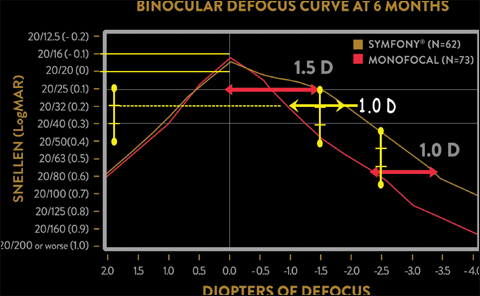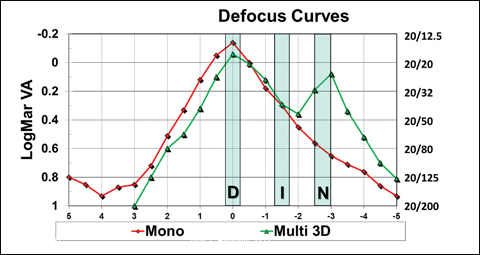Should I choose distance vision in both eyes, monovision, EDOFs or multifocals?
Jack T. Holladay, MD, MSEE, FACS, discusses how to help the cataract surgery patient choose the best IOL.

Deciding the refractive target and IOL for cataract surgery is a daunting task for both the surgeon and patient. The first two questions that must be answered are: Do you mind wearing glasses for intermediate and near tasks, and would the presence of halos and glare be acceptable in exchange for reducing your dependence on glasses?
If the patient does not mind wearing reading glasses, then providing the best distance vision in each eye is the goal. Using aspheric IOLs to reduce spherical aberration and produce the best retinal image quality, eliminating astigmatism and achieving a spherical equivalent prediction error near zero will lead to a high percentage of satisfied patients in this group.
Equal distance vision in both eyes also has the benefit of binocular summation: Both eyes are better than one. If each eye is 20/20, the patient will have 20/16 binocular acuity (one line better than each eye alone) and 40% (2.3 dB) better binocular contrast sensitivity (CSF), and if each eye is 20/40 at near, the patient will have 20/30 binocular near vision and normal stereopsis, which is nine out of nine circles (40 arc seconds) on the Titmus stereo vision test.

Images: Holladay JT

If the patient wants to reduce his dependence on reading glasses and halos and glare are acceptable, then extended depth of focus (EDOF) or multifocal IOLs work well. EDOF and 2.5 D, 3.0 D and 4.0 D multifocal IOLs cover the spectrum of intermediate and near vision. These are averages for a 22 D IOL and would be about 0.5 D less for a 10 D IOL and 0.5 D more for a 30 D IOL at the spectacle plane. Experience indicates that most patients prefer good intermediate distance (computers, arm’s length) and are willing to use readers for near (smartphones, prescription labels). Determining the preferred close distance dictates the appropriate add for the patient. Understanding that he can only have two out of the three distances (far and near or intermediate) must be made clear before surgery and is critical to success. The defocus curves for EDOFs and the 3 D multifocal and monofocal IOLs are shown in Figures 1 and 2. Notice that the EDOF has no “dip” in the curve.
If the patient has concerns about halos and glare, then EDOF and multifocal IOLs should probably be avoided. The only remaining choice for near is monovision. A patient having used monovision successfully in the past is certainly a plus, but one must keep in mind there is no accommodative reserve with pseudophakia, whereas before he probably had a small reserve. Traditional monovision has a +1.50 D add in the nondominant eye and the dominant eye is targeted for distance. Mini-monovision is from +0.75 D to +1.25 D, micro-monovision is +0.50 D, and high monovision uses +2.50 D or above.
Traditional monovision of +1.50 D in the nondominant eye provides 20/25 at near, and there is no binocular summation (or inhibition). The binocular performance is equal to the better eye (acuities of 20/20 at distance and 20/25 at near), CSF is the same as monocularly, and three circles of stereopsis are lost (six out of nine, or 80 arc seconds). In contrast, at +2.50 D of high monovision, there is binocular inhibition. Binocularly, there is a one line loss of visual acuity than the better eye at distance and near and a 40% (2.3 dB) loss in CSF and more than three circles loss of stereopsis. This is why +1.50 D is commonly referred to as the “sweet spot” for monovision because binocular inhibition begins with higher adds.
Determining whether a patient who has never tried monovision will be successful requires a trial. Many experts feel the trial should be done with a soft contact lens for a few hours up to a day so the patient can perform most of the vision tasks required. A +1.50 D using a trial spectacle lens in the office is usually felt not to be sufficient. With 20/50 or better with cataracts, a soft contact lens trial is a good predictor, but with worse vision, it is not always indicative of actual visual performance after cataract surgery.


Table 1 compares the various modalities discussed above. Mixing modalities (aspheric monofocal and EDOF or multifocal IOLs) is not recommended. When the patient compares eyes, he is continually reminded of difference in the retinal images. Neuroadaptation is much easier when the retinal images are similar, such as mixing the add powers of multifocal (and EDOF) IOLs to provide the patient with a greater binocular range of close vision. The size of the halo with multifocal and EDOF IOLs is directly proportional to the add, so EDOFs have a smaller halo than a +2.5 D add, which is less than +3.0 D add, etc.
Table 2 shows current practice patterns with the prevalence of various IOLs. It will be interesting to see what the market share of EDOFs will be with time. They will definitely compete with traditional monovision and are on the rise. The spectrum of choices, from monofocal, EDOF, low and high multifocal IOLs, appears to cover the range of near and intermediate vision, but the 3 D accommodating IOL at the spectacle plane is still over the horizon.
- For more information:
- Jack T. Holladay, MD, MSEE, FACS, is a clinical professor of ophthalmology at Baylor College of Medicine and the OSN Optics Section Editor. If you have any clinical optics questions, please send them to holladay@docholladay.com. Previous articles in the Clinical Optics 101 series may be found at http://www.healio.com/ClinicalOptics101.
Disclosure: Holladay reports he is a consultant to Abbott Medical Optics, Alcon Laboratories, ArcScan, Calhoun Vision, Carl Zeiss, Elenza, M&S Technologies, Oculus and Visiometrics.
